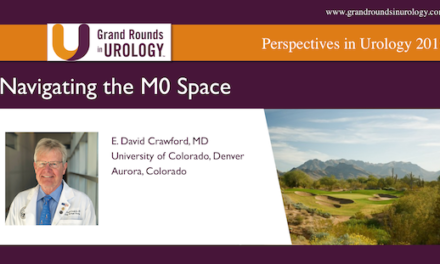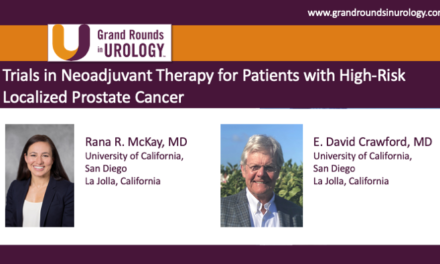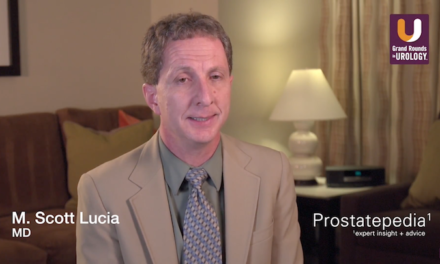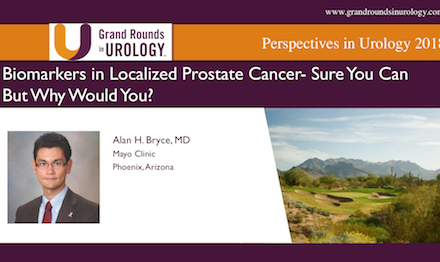Dr. Shore presented at the 26th International Prostate Cancer Update on Friday, January 22, 2016 on “There Are Newer and More Promising Agents Than Chemotherapy.”
Keywords: prostate cancer, chemotherapy, biochemicals, androgen, immunotherapy
How to cite: Shore, Neal. “There Are Newer and More Promising Agents Than Chemotherapy” Grand Rounds in Urology. January 22, 2016. Dec 2024. https://dev.grandroundsinurology.com/more-promising-agents-than-chemotherapy
Transcript
There Are Newer and More Promising Agents Than Chemotherapy
Wonderful meeting as always 26 years in a row thanks to Dave Crawford, who continues to make sure we get a fabulous agenda. Always keeping it fresh new and cutting-edge and really helping make this really one of the premier meetings in terms of it being educational, opportunities to interact with academia, community-based physician’s, medical oncology or and urology, radiation oncology. I think it’s awesome.
All right so this is the first slide and you know this is another way to think about the demographics and at least in the U.S. regarding the newly diagnosed patients. There is certainly to be presumably now with less screening we’re going to see more patients newly diagnosed with metastatic disease. Here some of the breakdowns. Looking at those patients who are getting prostatectomy versus active surveillance and/or radiation. But the bottom line is as we’re going to have more patients most likely as we treat with local therapy. Higher risk patients will probably have more failures. We’ll probably have more biochemical relapse, which makes for a you know a lot of controversial interpretive decision making.
Here’s some more statistics looking at that group now biochemical or PSA relapse patients going into the M0 state which many have argued is an artificial state and its limited by or its artificial in its micro metastatic versus macro metastatic disease. Essentially limited by the accuracy or the sensitivity of the radiologic tests that you are able to perform. And Philip Koo has talked a lot about that and as we move forward in certainly other parts of the world outside the United States are leading the charge looking at more sophisticated pet scanning whole body MRI. Are academic centers and have some data on that we need more prospective data but no doubt micro metastatic disease will morph into macro metastatic disease with greater radiographic accuracy.
That said there are many patients who go on to develop confirmed disease. And where are we going to be treating them whether their castration resistant or hormone sensitive in these different lines of therapy. And my understanding is as the prosecutor working group comes out will start to get rid of this arbitrary distinction of chemotherapy before or after and rather think about lines of therapy. So Dan gave a great presentation earlier today on chemo hormonal therapy combining typically six cycles of docetaxel and with prednisone without prednisone. The charter was without the stampede was with and androgen deprivation therapy. And the data seems pretty clear that it’s in high-volume patients that he decide to describe for bone lesions and/or visceral metastases and typically one lesion in the appendicular skeleton.
So what’s the rationale behind the combination and we know with androgen deprivation therapy we have are what we create is regression of certain androgen sensitive clones. So the pro for adding in the chemotherapy would be to attack the these independent clones early. Perhaps the ones that are ARB seven positive or others there may be some benefit to docetaxel actually working as an AR inhibitor an additional, in addition to the well-known effect on tubulin inhibition. The con is that were taking these some ADT will take cells out of the cycle and be less responsive to future use of taxing base therapy. And in some patients may respond to ADT for a very long period of time and perhaps never need chemotherapy and maybe either have stabilization of their disease or die of something else.
Another thing that’s really interesting to think about was a wonderful poster of analysis by Turpine and I don’t have a slide on it at ASCO GU this year is. What you do that patients who have androgen sensitive disease who you give chemo hormonal therapy to who are resistant to the chemotherapy but are still androgen sensitive. I want to ask Dan that question and get his thoughts on it and the answer is really don’t know. So the role of the tumor at epithelial mesenchymal transition and metastases and therapeutic resistance. I brings your attention you look at this slide and what I find really interesting about it goes back to the controversy for the our patients is it a development of a primary localized tumor or is it something that’s actually starting in this in the marrow? But from the stem cell population and it leads to a question of our really what’s the best time to impact upon patients with highly aggressive disease. And the answer is we still don’t know that.
So in 2013 at the end of the year this was the last title cover on Science, which was cancer immunotherapy. This was 2013 is the future and we all know the explosion of of the tech of these advances now and other solid tumors beyond prostate. But prostate certainly led the way starting with CPT back in 2010. So this tale of the curve by Verdeil I think is a very important slide to understand. Thank you Tracy McGowan for lending this to me. But it sets immunotherapy apart from targeted therapy. So on the top line sees the future of immunotherapy and its tale of the curve is basically keeping patients alive longer. Really getting patients into a stabilization or an equilibrium phase of their disease. Our current immunotherapy versus future sees the increase of the tale of the curve. Another way of thinking about that’s in the roller coaster slides and everybody typically shows is flattening out that portion of the curve that leads to death.
So is it immunotherapy plus an oncologic or is it a combined immunotherapies with additional oncologic or is it with certain now already available targeted therapies, such as the novel hormonal lines of therapy that we have. So targeting the T cell this is just a simplified version of the various antibody responses whether their checkpoints or activating a T cell therapies. The CD cluster differentiation all these different ones these are clearly not an exhaustive list. But you can do T cell stimulation as we learned about accelerating, hitting the gas pedal and relieving the the break in the checkpoints. It’s pretty well known that PD1 and PDL1 there is a paucity of their expression in prostate cancer, but there certainly other receptors that were looking at. So that again this is important in understanding will chemotherapy continue and take on its primary role. I worry we’ve adapted certainly my clinic I’m a believer in the chart of the STAMPEDE data. But I do think the future is bright looking at the CAT, the cancer immunotherapy cycle. And you can read through this starting at one at the bottom of the 6 o’clock position. As antigens are released in various antigen presenting cells can pick up or not or do they potentially need to be initiated and primed for further activation? Ultimate trafficking of these activated T cells to the throughout the reticular endothelial system leads to infiltration of T cells or tumor infiltrate infiltrating lymphocyte or tills which I can be studied and monitored.
So here is just a numerous oncologic vaccines that are being developed. I’m going to talk about several of them that we’re doing in my clinic and trials that were enrolling patients in. And this goes from preclinical this is certainly not an exhaustive list because I’m going to tell you today about the Inovio trial that were doing in biochemical relapse, PSA relapse patients, not requiring ADT. And I will talk more about the Sotio trial that were doing with a combination of chemotherapy and immunotherapy getting back to that Verdeil curve of immunotherapy and oncology.
Here is the Inovio trial. This is pretty cool. This is it’s a Phase 1 study of patients with biochemical relapse who failed radiation or surgery and they get four injections in their shoulder and they can electroporation. So they get the needle get stuck in something like you know the early time tests that you had and they get an electrical stimulation this is a DNA plasmid PSAP SMA vaccine therapy. And we but we’ll be enrolling about 120 patients and I can tell you that’s really interesting. It’s open label in terms of different volumes of the plasmid and, and immune adjuvants. Extremely well tolerated and very appealing to patients because with biochemical relapse are for our go to his androgen deprivation therapy. We all know there’s a tremendous amount of toxicity associated with it. We’re looking at changes in tumor infiltrating lymphocyte but most importantly, this is really about safety and tolerability, and then will be doing additional trials.
So here’s a survey and a study I did with Ashley Ross with the Prostate Cancer Foundation this past spring thinking about that group and the ARS question I gave you on very high risk and oligo metastatic prostate cancer patients. There’s an uncertain standard of care we had multiple advances. We’ve had improved disease identification and imaging. We’ve had improved surgical radiation-based therapies both for the primary and the focal lesions. And we’ve had improvement systemic therapies, but there a lot of different questions what’s the best local primary if you’re going to do something local? What’s the best treatment for metastatic sites, early intensification systemic therapy? We need controlled clinical trials the problem is most of the data in single institutional trials and Europe. And the Germans are actually doing quite a lot of good work with this.
Now are starting to do some catch up on. So here’s a survey that we did. We a little you know quick, a messaging on LUGPA. We this is a nice study that we did we combined 39 LUGPA members of large groups. As you can see here in addition to 39 members, or roughly 39 members of an academic institutions of the Prostate Cancer Foundation. And what we’re trying to do is understand the management of contemporary very high risk localized locally advanced oligo metastatic prostate cancer. And here’s some, here’s the design, now we had 39 and 33 respectively and we asked a whole series of questions of how, what your perspectives on local control high risk oligo metastatic systemic therapy, metastases directed therapy, perspectives and what you need to focus on in the future. We did this in the spring and this is really after everyone had potential opportunity to read charted STAMPEDE. Tremendous caveats with the survey for sure selection biases etc. but just kind of interesting information to see.
So terms of local control of the primary of the prostate use of therapy for the primary. Again this is in patients with very high risk localized locally advanced and oligo metastatic, use of therapy directly related to the primary, which would be either surgery or radiation. And one can see actually pretty good correlations of larger urology group and these are identified actually by me as folks who were very who spent most of their time in prostate cancer treatments, not infertility, incontinence kind of guys.
But look at the oligo metastatic, is the sort of the academics are having a much more aggressive viewpoint about that type of treatment to the primary. One can see x-ray and external beam radiation versus radical prostatectomy, in comparing of the academic survey versus the community practice actually pretty consistent. Now use of systemic chemotherapy and this was a I thought was actually a very interesting as well again this for oligo metastatic patients. About 40% in agreement of systemic therapy I think that numbers going to change over time. And there was some variations on this analysis based upon you know PSA. Use of local treatment of metastatic sites whether it’s stereotactic radiation therapy, a more aggressive approach by our academic colleagues versus the community based. Which is interesting because a lot of people would say that the there’s ownership there and there was actually less consideration for that amongst these groups and in fact about 90% of the community-based loved the groups had some form of radiation oncology affiliation.
So future areas of focus what are the survey from PCF membership say? Well determine best local therapy better, imaging, stereotactic radiation therapy in metastatic disease immunotherapy, and one can see the list of the community. I’m pretty similar with some other thoughts on small molecule inhibitors, better and being better informed on androgen deprivation therapy. About Tom Keane’s presentation was excellent his questions were really pivotal showing even how a lot of folks are not even getting baseline testosterone before initiating ADT.
So here are some of the conclusions of that survey and oligo metastatic disease high risk patients, biochemical relapse certainly areas of unmet need. Combination therapy going back to the concept of adding immunology or immunotherapy on top of other immuno therapeutic’s, breaks, accelerators versus adding chemotherapy. We’ll talk a little bit more about that. There’s a spectrum of cancer immunotherapy’s that are out there now with varying combination platforms, and one of things that’s now you know really front and center is the need the different approaches to understanding splice variants. And one can see here is the great work done by Antonarakis and Alan Partin and their group at Johns Hopkins and further identifying the V7. There’s really wonderful work being done by Howard in moral and epic sciences. And some immuno-histochemistry work is being done by biopsies at M.D. Anderson.
There’s a hot area but it’s a hot area of importance because it will help better define how we’re going to treat these patients with high risk localized disease biochemical relapse, who really need to be treated or not and patients with oligo metastatic disease. So it what we see in what’s very clear is that when you have the V7 that our current a novel hormonal lines of therapy whether it’s Abi or Anzi are essentially not effective. And that really speaks to those waterfall plot curves that shows the PSA, those are a small number of patients in the pre-chemo or post-chemo trials that never have PSA reduction. And we don’t have the correlates on them regarding their splice bearing activity. In all those patients for sure but were surely getting there it certainly seems appealing that that’s what’s going on and perhaps other somatic or germ line mutations.
So Galeterone is actually very interesting to me were participating in this trial and I think it’s a very important trial because the first trial that actually the FDA signed off on really will speak towards precision medicine approach towards our registration of approval. And this is a novel oral therapy that has three different mechanisms of action inclusive of SIT 17 inhibition and AR antagonism much like Abi and Anza but also acts as an ARD degrader as well steroids are not required. They have had no seizure activity to today.
Here’s the ARMOR3 trial. This is a phase 3. This is an important study because it’ll be a first one could argue precision medicine prostate cancer pivotal trial. Patients will be randomized based upon their V7 status. They have to be the seven positive probably and naïve through therapies in the M1 CRPC population. They’ll get randomized to either Abiraterone or Enzalutamide. And so is going to be probably big population that will have to be screened in order to probably get onto a 10 to 15% prevalence in this population. But this is a registration trial as approved by the FDA.
So the other, so we’re enrolling in that we’re doing you know and here’s another one this is a combination this is SOTIO company that is called there, this is a Phase 3. And so that had Phase 2 data that had definitely shown an interesting progression free survival benefit. But this is a randomized double-blind multicenter parallel group Phase 3 trial to evaluate patients with M1 CRPC. It’s there DC vaccine with combining with chemotherapy versus a placebo in men with metastatic castration resistant prostate cancer. They placebo arm patients do get chemotherapy.
So this is probably hard to see but this is patients get a leukapheresis much like they do the Sapolacell LT model their androgen presenting cells are harvested in the vaccine is created. The vaccine is administered back subcutaneously and it’s administered after patients have received and have begun a course of a full dose docetaxel chemotherapy. Concept here is that by giving docetaxel chemotherapy you reduced T regulatory suppressor cells and potentially enhance the immune system. The tumor cells that are uses a link cap cell line to create the vaccine.
Here’s the schema itself seems a little bit busy but this pretty cool, we’ve enrolled quite a number patients on this right now. And were you find a very good tolerability as you saw in terms of the vaccine. The usual tolerability’s and safety issues regarding docetaxel most of the patients have been at 75 mg. per meter square some of we’ve dose reduced to 60.
So this is in the CRPC population but certainly one can envision moving this earlier into androgen sensitive metastatic patients as well. If indeed like most registration pathways you start with these patients because their end point of survival is more rapidly met. In the STAMPEDE trial, Dan did a really good job talking about that and how it differed in terms of the eligibility vis-à-vis other charted. It’s a little bit more broad in scope and you see all of this is a trial that was started with multi-arm multi-state. I think it’s rather very clever, and that the folks in the UK with some couple sites in Switzerland are really leading this. They’re getting huge numbers of patients to enter into these arms. And us so we talked earlier about the abiraterone, zoledronic acid, docetaxel arm which didn’t show any benefit. But yet the ADT’s old zoledronic acid celecoxic arm did show survival benefit.
So very interesting, other arms of the Abi, the docetaxel ADT arm is fully accrued and they’ll continue to enroll in a think it’s a great service to us. And here’s the data from ASCO GU as presented by Nick James. And so now you have and I think there is a potential indication for this and in certain parts of the world Dan Patrick when I asked him that question they said well there’s the issue about cardiovascular toxicity. But for someone who’s unfit for chemotherapy and or you’re not comfortable in administering chemotherapy or you don’t have access to it or you have the right growth factors to support it. One can make an argument for considering giving this this combination now for this group of patients. So we don’t truly understand it all but Bersarter did a great job of reviewing it. He seemed to suggest he doubted that anybody would recapitulate this trial. But nonetheless the data is the data.
So there are newer therapeutic possibilities and I can put the slide together and setting of using a high risk localized bucket is A. And in biochemical relapse PSA relapses is B. And Androgen sensitive metastatic and CRPC is both C&D. There is the possibility of these newer pot things other than chemotherapy might be really a really broad array of androgen annihilation in combination with intervention. And so maybe we do need to remove the ablate with radiation or some thermal ablation or prostatectomy in commendation with systemic therapy. And then there certainly is a robust world out there looking at different immunotherapeutic now in the biochemical relapse world. We all know if we could do that and not have to lower testosterone levels that would be a manna from heaven for our patients as no one wants to have a T depletion.
And then of course in our patients with more high-volume disease the combinations chemo hormonal, chemo immunologic and/or targeted selected combinations, it certainly makes it a remarkably exciting time for us. For those of us and I’m most of us in this room I’m sure treating patients with high risk prostate cancer.
ABOUT THE AUTHOR
Neal D. Shore, MD, FACS, is the Medical Director for the Carolina Urologic Research Center. He practices with Atlantic Urology Clinics in Myrtle Beach, South Carolina.
Dr. Shore has conducted more than 350 clinical trials, focusing mainly on genitourinary oncology, and serves on the executive boards of the Society of Urologic Oncology and the Bladder Cancer Advocacy Network. He is Past President of the Large Urology Group Practice Association. He is a founder for both CUSP Clinical Trials Consortium and DASHKO, a national urology practice data registry. He serves as the National Urology Research Director for 21st Century Oncology. He has served on the AUA Male Health Committee and the AUA Data Committee, the SITC Task Force for Prostate Cancer, the Bladder Cancer Advocacy Think Tank, and the Editorial Boards of Review in Urology, Urology Times, Chemotherapy Advisor, OncLive, PLOS ONE, Urology Practice, and World Journal of Urology. He serves as Editor of Everyday Urology-Oncology. Dr. Shore has written more than 200 peer-reviewed publications and numerous book chapters. He performs peer review for Lancet Oncology, New England Journal of Medicine, European Urology, the Journal of Urology, Urology, BJUI, PCPD, and numerous other high-impact scientific journals.
A graduate of Duke University and Duke University Medical School, Dr. Shore completed a 6-month clinical research fellowship in Pretoria, South Africa, and then completed his General Surgery/Urology training at New York Hospital Cornell Medical Center and at Memorial Sloan-Kettering Cancer Center in New York City. He is a Fellow of the American College of Surgeons.





